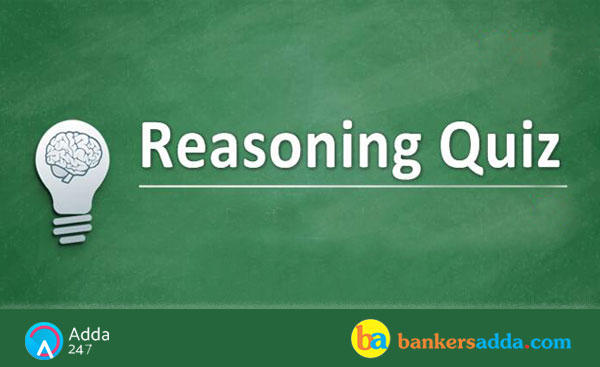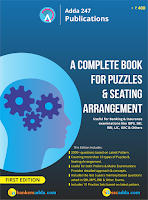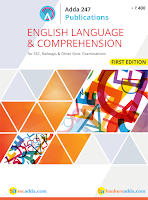Dear Aspirants,
Reasoning Ability is an onerous section. With the increasing complexity of questions, it becomes hard for one to give it the cold shoulder. The only way to make the grade in this particular section in the forthcoming banking exams is to practice continuously with all your heart and soul. And, to let you practice with the best of the latest pattern questions, here is the Adda247 Night Reasoning Quiz based on the exact same pattern of questions that are being asked in the exams.
Directions (1-5): Study the following information to answer the given questions:
Eleven persons Z, B, X, W, V, U, G, H, I, J and P are sitting in a row facing North. Only four of the given eleven persons are carrying money with them in the form of one rupee coins. But not more than two of such persons(carrying money) can sit together. One of the immediate neighbours of Z is carrying some money and he has one coin less than the number of person sitting to the left of him. J is an immediate neighbor of Z and B. The amount of money W has is the same as the sum of the number of coins of all the persons sitting to the left of him. H is to the immediate left of W and third to the right of I. Immediate neighbour of U has one coin less than him. One of the immediate neighbours of X is carrying coins. W, who is to the immediate left of U, is second to the right of X. J sits third to the left of G. Z, is second to the right of V, who is at one of the ends. U has same number of coins as the number of persons sitting between him and the person who has two coins.
Q1. Who among the following has three coins?
(a) X
(b) I
(c) B
(d) G
(e) None of these
Q2. How many persons are sitting to the left of the person with the highest number of coins?
(a) No one
(b) One
(c) Three
(d) Two
(e) More than three
Q3. Which of the following persons sits to the immediate left of Z?
(a) P
(b) J
(c) B
(d) I
(e) None
Q4. What is the sum of money possessed by the persons sitting to the left of H?
(a) Ten rupees
(b) Eleven rupees
(c) Eight rupees
(d) Five rupees
(e) None of these
Q5. How many persons sitting between W and J are carrying coins?
(a) Two
(b) One
(c) None
(d) Three
(e) None of these
Direction (6-10): Study the following information carefully and answer the given questions.
Eight persons viz. M, N, O, P, Q, S, T and U are sitting around a circular table facing towards the centre. Each of them likes different plants viz. Areca palm, Aloe Vera, Rose plant, Sunflower Plant, Snake plant, Money plant, Holy basil and Mistletoe plant (but not necessarily in the same order).
P who likes Money plant sits third to the right of the one who likes sunflower plant. The one who likes Aloe Vera and the one who likes Mistletoe plant are immediate neighbours of each other. The persons who like Holy basil and the Areca palm are sitting immediate next to each other. The one who likes Aloe Vera sits second to the right of Q who likes Snake plant. S likes Holy basil. U is not an immediate neighbour of the one who likes Aloe Vera. The one who likes Mistletoe plant and the one who likes sunflower plant are not immediate neighbours of each other. O is the only person sitting between the persons who like Aloe Vera and Sunflower plant. M sits third to the right of the one who likes Areca palm. U likes sunflower plant.
Neither the one who likes Aloe Vera nor the one who likes Mistletoe plant is an immediate neighbour of P. The one who likes Holy basil is not an immediate neighbour of the person who likes Money plant. N does not like Aloe Vera.
Q6. Which of the following pairs represents the immediate neighbours of U?
(a) Aloe vera – Rose plant
(b) Areca palm – Aloe Vera
(c) Holy basil – Rose plant
(d) Snake plant – Mistletoe plant
(e) None of these
Q7. What is the position of the person who likes Rose plant with respect to N?
(a) Third to the left
(b) Second to the left
(c) Immediately to the right
(d) Fourth to the right
(e) Second to the right
Q8. Who sits fifth to the right of the N?
(a) The one who likes Money plant
(b) U
(c) The one who likes Holy basil
(d) The one who likes Snake plant
(e) None of these
Q9. How many person sits between P and the one who likes Rose plant when counted in counter clockwise direction from P?
(a) One
(b) Two
(c) Four
(d) Three
(e) None of these
Q10. Who among the following likes Mistletoe plant?
(a) Q
(b) T
(c) N
(d) P
(e) M
Directions (11-15): Study the following information carefully and answer the given questions:
In a certain code
‘here is tunnel she stop’ is written as ‘isa kin ha ti la’,
‘he goes through tunnel’ is written as ‘nit ti pi sit’,
‘she goes here often’ is written as ‘sit la tin isa’ and
‘tunnel is far through here’ is written as ‘ha nit la ti fa’.
Q11. Which of the following is the code for ‘tunnel’?
(a) nit
(b) ti
(c) la
(d) na
(e) None of these
Q12. What does code ‘sit’ stand for?
(a) goes
(b) through
(c) he
(d) Can’t be determined
(e) None of these
Q13. ‘he is often’ can be coded as
(a) sa pi la
(b) fa tin ha
(c) pi ha tin
(d) kin tip sit
(e) None of these
Q14. Which of the following is the code for ‘stop’?
(a) la
(b) tip
(c) sit
(d) kin
(e) None of these
Q15. Which of the following is the code for ‘goes here far stop’?
(a) sit la fa kin
(b) la fa pi tin
(c) ha kin sit nit
(d) Can’t be determined
(e) None of these




 Reasoning Quiz For Bank Foundation 2024 ...
Reasoning Quiz For Bank Foundation 2024 ...
 Reasoning Quiz For Bank Foundation 2024 ...
Reasoning Quiz For Bank Foundation 2024 ...



